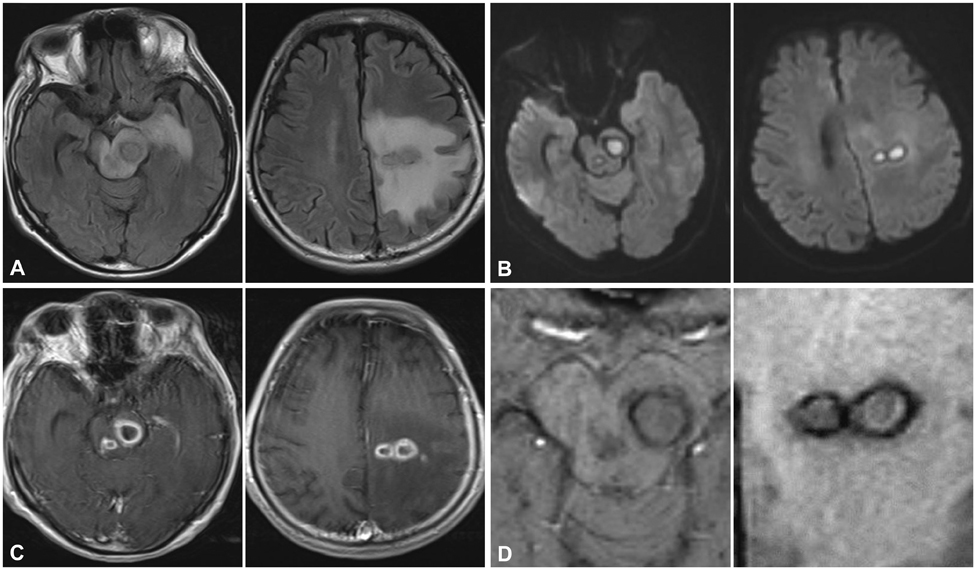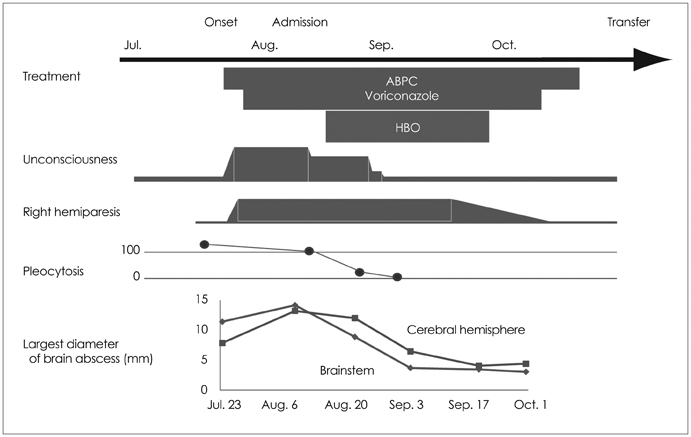J Clin Neurol.
2014 Oct;10(4):358-362. 10.3988/jcn.2014.10.4.358.
Drastic Therapy for Listerial Brain Abscess Involving Combined Hyperbaric Oxygen Therapy and Antimicrobial Agents
- Affiliations
-
- 1Department of Neurology, Graduate School of Medical Sciences, Kumamoto University, Kumamoto, Japan. y-stsh@kumamoto-u.ac.jp
- 2Department of Neurology, National Hospital Organization, Kumamoto Medical Center, Kumamoto, Japan.
- KMID: 2287517
- DOI: http://doi.org/10.3988/jcn.2014.10.4.358
Abstract
- BACKGROUND
Listeria monocytogenes (L. monocytogenes) is a rare causative pathogen of brain abscess that is often found in immunocompromised patients. Although patients with supratentorial listerial abscesses showed a longer survival with surgical drainage, the standard therapy for patients with subtentorial lesions has not been established.
CASE REPORT
We report herein a patient with supra- and subtentorial brain abscesses caused by L. monocytogenes infection. These abscesses did not respond to antibiotics, and his symptoms gradually worsened. Drainage was not indicated for subtentorial lesions, and the patient was additionally treated with hyperbaric oxygen therapy, which dramatically reduced the volume of abscesses and improved the symptoms.
CONCLUSIONS
This is the first report of drastic therapy for a patient with listerial brain abscesses involving combined antibiotics and hyperbaric oxygen therapy. The findings suggest that hyperbaric oxygen therapy is a good option for treating patients with deep-seated listerial abscesses and for who surgical drainage is not indicated.
Keyword
MeSH Terms
Figure
Reference
-
1. Lorber B. Listeriosis. Clin Infect Dis. 1997; 24:1–9. quiz 10-11.
Article2. Clauss HE, Lorber B. Central nervous system infection with Listeria monocytogenes. Curr Infect Dis Rep. 2008; 10:300–306.
Article3. Toh CH, Wei KC, Chang CN, Hsu PW, Wong HF, Ng SH, et al. Differentiation of pyogenic brain abscesses from necrotic glioblastomas with use of susceptibility-weighted imaging. AJNR Am J Neuroradiol. 2012; 33:1534–1538.
Article4. Sav H, Atalay MA, Demir G, Akif Ozdemir M, Nedret Koc A. Early diagnosis of cerebral aspergillosis with various methods: a case report. Infez Med. 2013; 21:134–138.5. Dalton CB, Austin CC, Sobel J, Hayes PS, Bibb WF, Graves LM, et al. An outbreak of gastroenteritis and fever due to Listeria monocytogenes in milk. N Engl J Med. 1997; 336:100–105.
Article6. Drevets DA. Dissemination of Listeria monocytogenes by infected phagocytes. Infect Immun. 1999; 67:3512–3517.
Article7. Maezawa Y, Hirasawa A, Abe T, Kawamura H, Sekiguchi K, Kunimoto M, et al. Successful treatment of listerial brain abscess: a case report and literature review. Intern Med. 2002; 41:1073–1078.
Article8. Eckburg PB, Montoya JG, Vosti KL. Brain abscess due to Listeria monocytogenes: five cases and a review of the literature. Medicine (Baltimore). 2001; 80:223–235.9. Tunkel AR, Glaser CA, Bloch KC, Sejvar JJ, Marra CM, Roos KL, et al. The management of encephalitis: clinical practice guidelines by the Infectious Diseases Society of America. Clin Infect Dis. 2008; 47:303–327.
Article10. Harwick HJ, Kalmanson GM, Guze LB. In vitro activity of ampicillin or vancomycin combined with gentamicin or streptomycin against enterococci. Antimicrob Agents Chemother. 1973; 4:383–387.
Article11. van de Beek D, Brouwer MC, Thwaites GE, Tunkel AR. Advances in treatment of bacterial meningitis. Lancet. 2012; 380:1693–1702.
Article12. Beynon C, Neumann JO, Bösel J, Unterberg AW, Kiening KL. Stereotactic biopsy and drainage of a brainstem abscess caused by Listeria monocytogenes. Neurol Med Chir (Tokyo). 2013; 53:263–265.
Article13. Lampl LA, Frey G, Dietze T, Trauschel M. Hyperbaric oxygen in intracranial abscesses. J Hyperbaric Med. 1989; 4:111–126.14. Kutlay M, Colak A, Yildiz S, Demircan N, Akin ON. Stereotactic aspiration and antibiotic treatment combined with hyperbaric oxygen therapy in the management of bacterial brain abscesses. Neurosurgery. 2005; 57:1140–1146. discussion 1140-1146.
Article15. Vannini L, Lanciotti R, Baldi D, Guerzoni ME. Interactions between high pressure homogenization and antimicrobial activity of lysozyme and lactoperoxidase. Int J Food Microbiol. 2004; 94:123–135.
Article16. Kurschel S, Mohia A, Weigl V, Eder HG. Hyperbaric oxygen therapy for the treatment of brain abscess in children. Childs Nerv Syst. 2006; 22:38–42.
Article17. Cone LA, Leung MM, Byrd RG, Annunziata GM, Lam RY, Herman BK. Multiple cerebral abscesses because of Listeria monocytogenes: three case reports and a literature review of supratentorial listerial brain abscess(es). Surg Neurol. 2003; 59:320–328.
Article
- Full Text Links
- Actions
-
Cited
- CITED
-
- Close
- Share
- Similar articles
-
- Treatment of radiation-induced cystitis with hyperbaric oxygen
- A Basic Survey for Regional Capability of Hyperbaric Oxygen Therapy to Multiple Fire Victims
- Early experience of hyperbaric oxygen therapy in radiation-induced cystitis
- Percutaneous Drainage Combined with Hyperbaric Oxygen Therapy for Pyogenic Spondylitis with Iliopsoas Abscess
- Hyperbaric Oxygen Therapy on Pyoderma Gangrenosum - A case report



